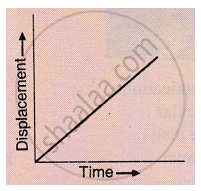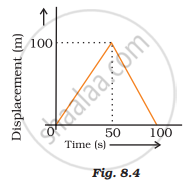Advertisements
Advertisements
प्रश्न
A stone thrown vertically upwards takes 3 s to attain maximum height. Calculate
- initial velocity of the stone
- maximum height attained by the stone. (Take g = 9.8 ms−2)
उत्तर
Initial velocity of the stone = u =?
At highest point, final velocity = v = 0
Time = t = 3s
Acceleration = a = −g = −9.8 ms−2
Maximum height attained by stone = S = h = ?
(i) v = u + at
0 = u + (−9.8) 3
u = 9.8 × 3 = 29.4 ms−1
(ii) Now, S = ut + `1/2` at2
h = `(29.4)3+1/2(-9.8)(3)^2` = 88.2 − 4.9 × 9
= 88.2 − 44.1 = 44.1 m
APPEARS IN
संबंधित प्रश्न
When will you say a body is at non-uniform acceleration?
What conclusion can you draw about the velocity of a body from the displacement-time graph shown below :

A motorcycle moving with a speed of 5 m/s is subjected to an acceleration of 0.2 m/s2. Calculate the speed of the motorcycle after 10 seconds, and the distance travelled in this time.
A bus running at a speed of 18 km/h is stopped in 2.5 seconds by applying brakes. Calculate the retardation produced.
A body starting from rest travels with uniform acceleration. If it travels 100 m in 5 s, what is the value of acceleration ?
A car acquire a velocity of 72 km per hour in 10 second starting from rest. Find
(1) the acceleration,
(2) the average velocity, and
(3) the distance travelled in this time.
Multiple choice Question. Select the correct option.
A body dropped from the top of a tower reaches the ground in 4s. Height of the tower is
Area under a v – t graph represents a physical quantity which has the unit
A girl walks along a straight path to drop a letter in the letterbox and comes back to her initial position. Her displacement–time graph is shown in Fig.8.4. Plot a velocity-time graph for the same.

Two stones are thrown vertically upwards simultaneously with their initial velocities u1 and u2 respectively. Prove that the heights reached by them would be in the ratio of `"u"_1^2 : "u"_2^2` (Assume upward acceleration is –g and downward acceleration to be +g)
